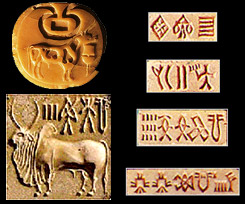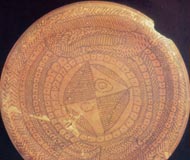
Over 5000 years ago, when the Egyptian and Mesopotamian civilizations were taking root, a more evolved and elaborate civilization was taking shape in the Indian sub-continent. In one of the most significant migrations that began in the 4th millennium BC, two groups of people moved from the eastern foothills of Baluchistan towards the Indus and Saraswati river valleys.
Out of this, one group settled down in the coastal areas such as Balakot. The other group explored Punjab and the north-western parts of Rajasthan. They populated Harappa and Kuchanwala beyond Kudawala and Kunal and then spread to Sindh, Gujarat and western Uttar Pradesh. These settlements came to be known as the ‘Harappan’ civilization or the ‘Indus Valley’ civilization. Some evidence of this civilization has also been found in Baluchi hills.
Put together, the Harappan civilization covered 1600 km from north to south and a similar distance from east to west. This is more than twice the combined territories of the Egyptian and Mesopotamian civilizations.

The Harappan civilization flourished for two thousand years from 3500 BC to 1500 BC. Based on time period, the Harappan civilization can be studied in three phases: the early phase (3500 BC—2600 BC); the mature phase (2600 BC—2000 BC); and, the late phase (2000 BC—1500 BC).
The Harappan civilization was highly skilled in designing cities and was undoubtedly the forerunner of modern day town planning. The tenements for the ruling class and the common man were segregated and other facilities such as lanes, by lanes, tanks, granaries, platforms for religious rites etc. were meticulously planned and executed in Harappan sites. This civilization had a script of its own which has not been deciphered so far.
Archaeologists have identified around 1400 Harappan sites in India and Pakistan so far. Beginning with Harappa in 1921-22 and Mohenjodaro the following year, about two dozen important sites have been excavated.
Following partition of Indian in 1947, Indian archaeologists excavated Lothal, Kalibangan, Surkotada and Rakhigarhi. The exploration of the dried-up course of the Vedic river Saraswati in India and Pakistan exposed 500 sites whereas the exploration of the Indus valley yielded only 150 sites.
The Harappan culture belonged to the Bronze Age. Excavation of Harappan sites have yielded artifacts and other objects of daily use made of copper and bronze. Ornaments and jewellery made of gold and silver embellished with precious stones and seals made of steatite and other materials have also been recovered from these sites.
Artistic works of the Harappans portray animals such as bulls, elephants, unicorns, tigers, crocodiles as also scenes depicting hunting, worshipping and characters of unknown mythologies.
Apart from intaglio and glyptic art of seals, other important works of art obtained from Harappan sites include the bronze sculpture of the ‘Dancing Girl’ and the image of Buffalo from Mohenjodaro; and, the male torso made of red sandstone and dancer made of black stone from Harappa. Other important objects include the images of the ‘Priest’ and Male Head from Mohenjodaro; a number of sculptures depicting men and animals made of ivory, shell and faience; terracotta figurines of Mother Goddess and bulls; sculpture of mongoose or monitor lizard; a mutilated stone icon of a nude male deity; and a terracotta model of Shiva ling in yoni-pitha.
The Harappans buried their dead in pits and pots or cremated them. Evidences of burial as well as cremation have been found in Harappan sites.
This is one of the most important galleries of the National Museum located on the ground floor. It was set up in collaboration with the Archaeological Survey of India. This gallery underwent modernization to upgrade display techniques and conservation measures recently.
Some 3800 objects from the National Museum collection are exhibited in this gallery representing various phases, aspects and sites of Harappan civilization. Out of these, 1025 objects come from the Archaeological Survey of India collection from excavated sites in India such as Lothal (District Ahmedabad, Gujarat); Dholavira (District Kachchh, Gujarat); Surkotada (District Kachchh, Gujarat); Banawali (District Fatehadbad, Haryana); Rakhigarhi (District Hissar, Haryana); Kalibangan (District Sri Ganganagar, Rajasthan).
The objects on display include pottery, seals, tablets, weights and measures, jewellery, terracotta figurines, toys etc. from various Harappan sites.



